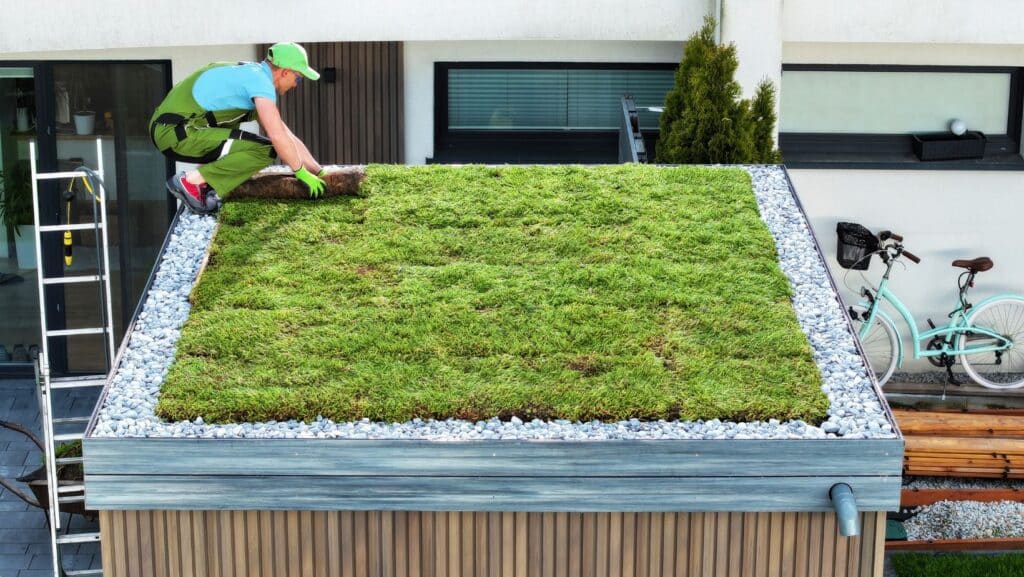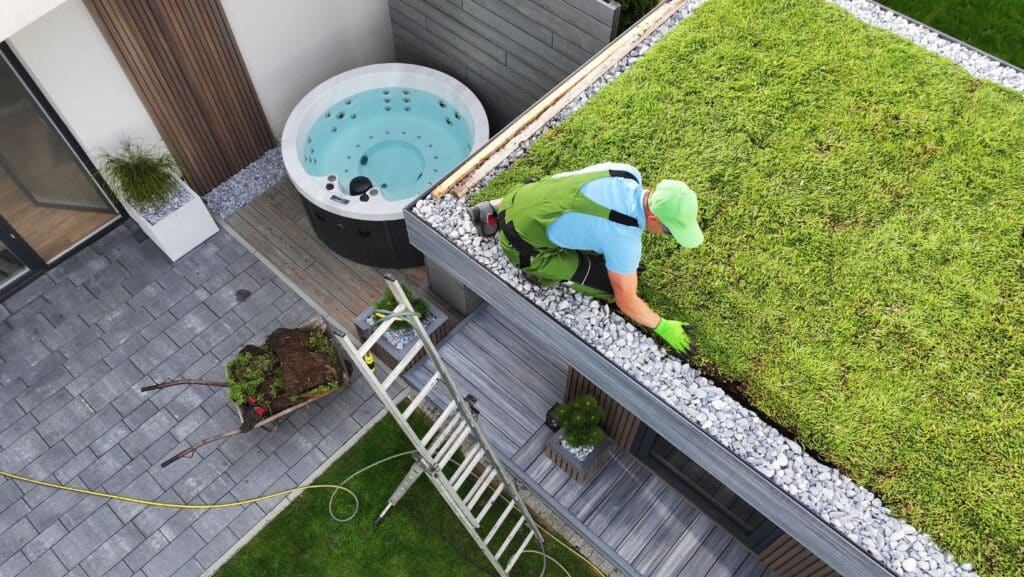As urban areas continue to expand, the quest for sustainable and environmentally friendly building practices has never been more critical. Among these practices, green roofing stands out as a revolutionary approach, merging aesthetic appeal with ecological benefits. Green roofs not only transform barren rooftops into lush gardens but also contribute significantly to urban biodiversity, energy efficiency, and the well-being of city dwellers. This blog post aims to delve into the world of green roofing, offering insights into its advantages, types, and key considerations for those looking to embrace this green innovation.
The concept of green roofing is not merely a trend but a testament to humanity’s ability to adapt and innovate for the betterment of the environment. By incorporating vegetation atop buildings, green roofs act as a natural insulator, a stormwater management tool, and a habitat for wildlife, all while beautifying the urban landscape. As we explore the multifaceted benefits and practical considerations of green roofing, we invite you to consider how integrating this sustainable practice can transform not just your property, but also contribute to a healthier, more resilient urban ecosystem.
Understanding Green Roofs

Green roofs, fundamentally, are an integration of vegetation, soil, and waterproofing systems installed on rooftops. They come in two primary types: extensive, which are lightweight, low-maintenance, and feature shallow soil depths suited for mosses, succulents, and grasses; and intensive, which are heavier, require more maintenance, and can support a wider variety of plants, including shrubs and small trees. This innovative roofing solution traces its roots back to ancient civilizations but has seen a resurgence in modern times as a response to the environmental challenges posed by urbanization.
The evolution of green roofing has been marked by significant technological advancements and a growing recognition of its environmental benefits. From ancient sod roofs to modern, engineered ecosystems, green roofs have been adapted across the globe to meet contemporary sustainability goals. The increasing interest in green roofs is a reflection of a broader commitment to sustainable development and urban resilience, showcasing how traditional practices can be reimagined to address modern environmental concerns.
Environmental Benefits
One of the most compelling arguments for green roofing is its substantial environmental benefits. By introducing vegetation to urban rooftops, green roofs create habitats for birds, insects, and other wildlife, contributing to increased biodiversity in cities. This addition of green space is vital in urban settings, where natural habitats are often scarce, helping to sustain a variety of species and promoting ecological balance.
Moreover, green roofs play a crucial role in improving urban air quality and mitigating the heat island effect, a phenomenon where built-up areas are significantly warmer than their rural surroundings. The plants on green roofs absorb carbon dioxide and other pollutants, while their soil and vegetation help cool the air, reducing the need for air conditioning in surrounding buildings and thus lowering greenhouse gas emissions. This natural cooling mechanism is essential in combating the rising temperatures in urban areas, making cities more livable and reducing their environmental footprint.
Water Management Advantages
Green roofs offer significant advantages in managing stormwater in urban environments. They act as natural sponges, absorbing and retaining rainwater, which reduces runoff and decreases the burden on city drainage systems. This capability is particularly important during heavy rainfall events, where traditional infrastructure might be overwhelmed, leading to flooding and water pollution. By capturing stormwater, green roofs help mitigate these risks, contributing to more sustainable urban water management practices.
In addition to managing stormwater, green roofs also contribute to water quality. The vegetation and soil layers filter pollutants from rainwater, helping to purify it before it reaches urban waterways. This natural filtration process can play a critical role in improving the health of local rivers and lakes, making green roofs a valuable component of urban environmental management strategies.
Energy Efficiency
Green roofs are renowned for their energy efficiency benefits. The layer of soil and vegetation provides natural insulation for buildings, reducing the need for heating in the winter and cooling in the summer. This thermal regulation helps to significantly cut down energy consumption, leading to lower utility bills and a reduced carbon footprint. The insulation offered by green roofs is a passive yet powerful way to enhance a building’s energy performance, showcasing the synergy between nature and architecture.
The impact of green roofs on a building’s thermal performance cannot be overstated. By moderating the temperature fluctuations on the roof, they help maintain a more consistent indoor climate, enhancing comfort for occupants while minimizing the reliance on mechanical heating and cooling systems. This energy-saving feature is particularly beneficial in urban areas, where the dense concentration of buildings and hard surfaces exacerbates the demand for energy-intensive climate control measures.
Economic and Social Impacts
The adoption of green roofing can also have significant economic benefits. Properties with green roofs often experience an increase in value due to their enhanced aesthetics, energy efficiency, and sustainability features. This increase in property value is a compelling incentive for developers and homeowners alike, making green roofs a smart investment in the future of real estate. Furthermore, the extended lifespan of green roofs, compared to traditional roofing materials, means lower replacement and maintenance costs over time, contributing to long-term savings.
Beyond the economic advantages, green roofs offer substantial social benefits. They provide much-needed green space in densely populated urban areas, improving the quality of life for residents by offering areas for relaxation, recreation, and social interaction. The psychological and health benefits of being in close proximity to nature are well-documented, including reduced stress levels and improved mental well-being. Green roofs can transform unused urban spaces into vibrant community assets, fostering a sense of community and connection to the environment.
Types of Green Roofs and Their Applications
Green roofs vary widely in their design and application, ranging from extensive systems with low-maintenance vegetation to intensive roofs that can accommodate a wide array of plants, including trees and gardens. Extensive green roofs are ideal for covering large areas with minimal structural impact, making them suitable for warehouses, office buildings, and residential homes. Intensive green roofs, on the other hand, require more investment and maintenance but offer greater biodiversity and recreational potential, making them perfect for public buildings and spaces where the roof is intended to be an accessible garden.
Between these two extremes lies the semi-intensive green roof, which offers a middle ground in terms of biodiversity, maintenance requirements, and structural load. This versatility allows for a wide range of applications, from enhancing the aesthetics of small commercial buildings to providing communal green spaces in residential developments. The choice between these types of green roofs depends on the specific goals, budget, and structural capabilities of the building, showcasing the adaptability of green roofing solutions to various urban contexts.
Planning and Implementation Considerations
Implementing a green roof requires careful planning and consideration of several key factors, including the structural capacity of the building, the climate, and the desired maintenance level. The weight of the green roof system, especially for intensive roofs, can significantly impact the structural design and necessitate additional support. Moreover, the selection of plants and the design of the irrigation and drainage systems must be tailored to the local climate and weather patterns to ensure the viability and sustainability of the green roof.
Professional consultation is crucial in the planning stage to address these considerations effectively. Experts in green roofing can provide valuable insights into the best practices for design, material selection, and maintenance, ensuring the success of the green roof project. Engaging with professionals early in the process can help avoid common pitfalls and ensure that the green roof meets both the aesthetic and functional requirements of the building.
Challenges and Solutions
While green roofs offer numerous benefits, they also present challenges, including higher initial costs and maintenance requirements compared to traditional roofs. However, these challenges can be mitigated through careful planning, selection of appropriate materials, and the incorporation of innovative technologies. For instance, modern waterproofing membranes and lightweight growing mediums have made green roofs more accessible and less burdensome in terms of weight and maintenance.
Advancements in irrigation and drainage systems have also simplified the maintenance of green roofs, making them more resilient and self-sustaining. By selecting native plants and employing smart irrigation technologies, green roofs can become low-maintenance ecosystems that thrive with minimal human intervention. These solutions not only address the practical challenges of green roofing but also enhance its environmental and economic benefits.
Green roofing represents a transformative approach to urban development, offering a harmonious blend of aesthetic beauty, environmental sustainability, and economic efficiency. As cities continue to grow, the adoption of green roofs can play a pivotal role in creating healthier, more resilient urban environments. Whether you’re a property owner, developer, or city planner, the benefits of green roofing are too significant to overlook.
If you’re considering integrating a green roof into your next project, Advosy is here to help. Our team of experts specializes in the design, installation, and maintenance of green roofs, offering tailored solutions that meet your specific needs and goals. Contact Advosy today to explore how green roofing can transform your property and contribute to a greener, more sustainable future.


